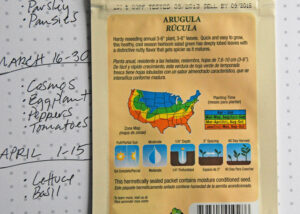Ringing in the New Year is filled with resolutions that usually involve dieting and exercise. Gardening is a great way to help accomplish those two resolutions, while also improving your mood, reducing blood pressure, managing anger, maintaining flexibility and much more.
So, gather anyone that shares in your gardening efforts and landscape projects. Grab a calendar and make some gardening plans for the year ahead. Consider including a monthly project that you all can share and one that moves you closer to your long-term gardening and landscaping goals.
Start the year right by growing some microgreens. They are quick, easy and require no special equipment. Plus, recent research found that many contain as much as 25 times more nutrients as the leaves of the full-grown plant.
Take some time to inventory your current seed collection. Decide what seeds you want to keep and grow this season and those you want to pass along to gardening friends. You may choose to make seed art with older or improperly stored seeds and invest in fresh seeds that are sure to germinate.
 Once you complete your inventory, review new catalogs, and make a list of seeds and plants you want to include this year. Order early for the greatest selection and availability. A recent increase in gardeners means more people shopping for the seeds and plants you want to buy.
Once you complete your inventory, review new catalogs, and make a list of seeds and plants you want to include this year. Order early for the greatest selection and availability. A recent increase in gardeners means more people shopping for the seeds and plants you want to buy.
While you wait for your seed order to arrive, prepare a space and organize supplies for starting any seeds indoors as needed. Clear a space, check your grow lights, and gather the needed seed starting mix and clean containers. Soak used containers in a one-part bleach and 9-parts water solution for ten minutes. Then rinse with clear water before reusing them this year.
Once you know what you want to grow, it is time to create a seed starting calendar. Check the catalogue, University Extension recommendations, and back of the packet to determine when you need to start the seeds indoors or out. Include dates for starting seeds indoors and directly in the garden. Note the recommended date for moving transplants into the garden. Add in time as needed to harden off transplants. Gradually introducing plants to the garden environment over a two-week period reduces transplant shock and increases your success.
Mark your calendar for peak harvest times in your region. Make sure to allow sufficient time for harvesting and preserving. Supplement your own harvest with produce from farmer’s markets and pick-your-own farms. Most post expected picking and produce availability dates on their website, so you can plan ahead. As the season begins, confirm picking times and invite family and friends for a harvest and preservation party.
Record all this information on your calendar, garden chart or a spreadsheet to help keep your gardening efforts on track. This will also help you identify the best time to embark on larger landscaping projects or hire a plant sitter when you are away from the garden.
Make this the year you resolve to accomplish your gardening goals in a timely manner. You’ll maximize your harvest, enjoyment, and other gardening benefits.
Melinda Myers is the author of more than 20 gardening books, including Small Space Gardening. She hosts The Great Courses “How to Grow Anything” DVD series and the nationally-syndicated Melinda’s Garden Moment TV & radio program
